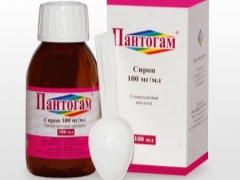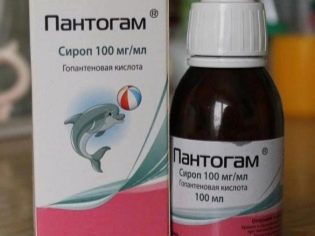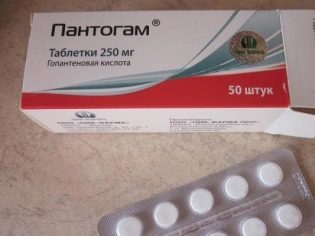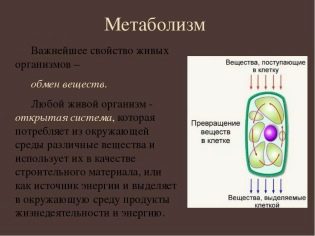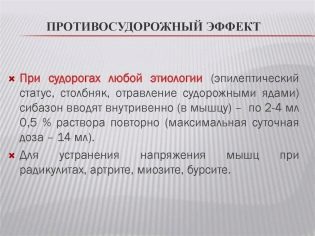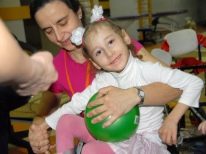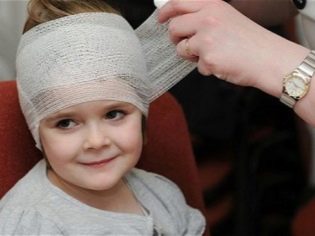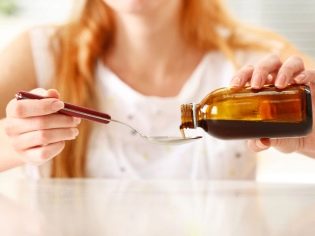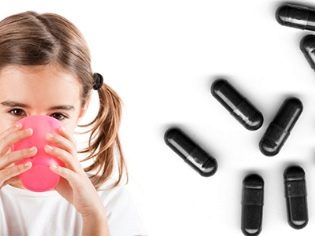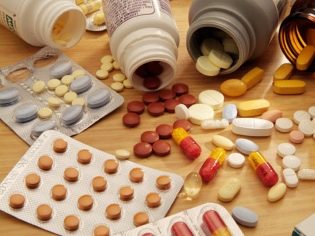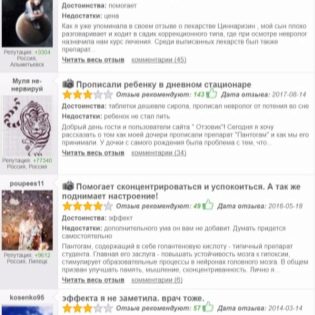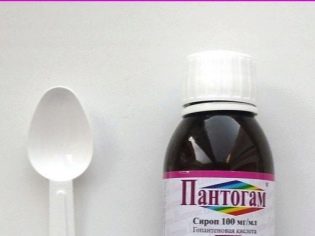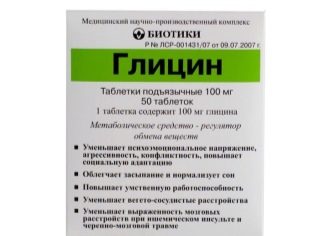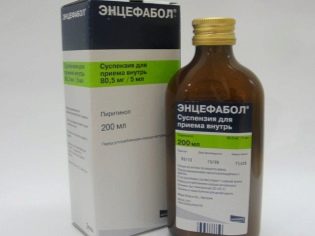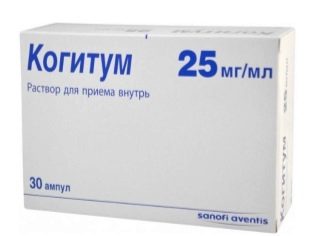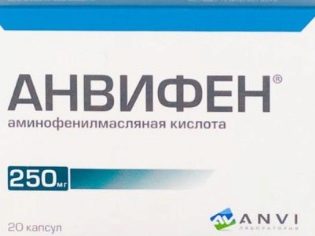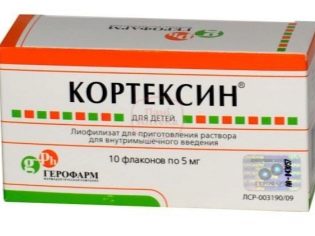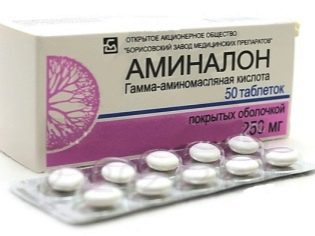Pantogam for children: instructions for use
Nootropic drugs have a positive effect on the state of the nervous system and are often prescribed for neurological pathologies. One of these tools is Pantogam. When it is prescribed to children, what dosages are prescribed, how long are they given in childhood, and what analogs are they substituted for?
Release form
The drug is available in two versions:
- Syrup. It is a thin transparent liquid with a smell of cherry, packed in glass bottles of 100 ml. A plastic spoon is attached to the bottle, which holds 5 ml of syrup and has divisions for 1.25 ml and 2.5 ml.
- Pills. They are flat and round, white in color, are at risk. There are 10 tablets in one blister, and one pack contains 50 pieces.
Composition
Both forms of the drug contain hopantenic acid as the main component. Such an acid is presented in Pantogam as gopantenate. calcium. This compound was patented and called "pantogam." One milliliter of syrup contains 100 mg of it, and one tablet in a dose of 250 mg or 500 mg.
In addition to calcium hopantenate, the syrup contains sorbitol, glycerin, sodium benzoate, aspartame, purified water, citric acid, and cherry flavoring. Auxiliary substances of solid form are magnesium hydroxycarbonate, talc, calcium stearate and methylcellulose.
Operating principle
Pantogam has a nootropic effect, as calcium gopantenate protects neurons from such harmful factors as toxic substances or lack of oxygen. The use of the drug has a positive effect on the metabolic processes in the brain cells, with the result that the drug improves performance and normalizes the excitability of brain tissue.
Pantogam also has some anticonvulsant effect what is used in the treatment of epilepsy.
In addition, it is noted that treatment with such a nootropic inhibits the gallbladder reflex (if it is pathologically elevated) and lowers the bladder detrusor tone.
Both syrup and tablets are absorbed very quickly in the digestive system, after which hopantenic acid is transferred to the cells of the brain, kidneys, skin and others. This substance in the body is not metabolized and in about 48 hours is completely excreted unchanged. In this case, 1/3 of the drug goes into the feces, and most of the drug leaves the body with urine.
Indications
Medication prescribed for:
- mental retardation;
- attention-deficit hyperactivity disorder;
- stuttering;
- nervous tikah;
- epilepsy;
- Cerebral palsy;
- neurological disorders of urination;
- developmental delay;
- reduced performance;
- schizophrenia;
- concussion;
- extrapyramidal disorders;
- perinatal brain damage;
- enuresis;
- mental overload;
- problems with remembering new material;
- traumatic brain injuries;
- cognitive impairment caused by neuroinfection;
- brain lesions toxic compounds.
How old is allowed?
Pantogam in syrup has no age limit and can be administered to infants, and preschoolers, and children of school age. The drug in tablets is not used in patients younger than 3 years. If the child is not yet three years old, he can only be given liquid Pantogam.
In the case when the patient is older than 3 years, but it is difficult for him to swallow solid medicine, syrup is also used.
Contraindications
Both forms of Pantogam are not prescribed:
- With intolerance to any of the components of the selected medication.
- With serious pathologies of the kidneys.
Syrup should also not be given with phenylketonuria, because aspartame is one of its ingredients.
Side effects
During the reception of Pantogam negative symptoms of the nervous system may appear, for example, insomnia, agitated state, headache, noise in the head. Some children, on the contrary, become lethargic, inhibited, drowsy. Most often, when these side effects are detected, the dosage is reduced and the undesirable reaction disappears.
Sometimes when treating pantogam on such a syrup or pill allergic reaction. If, after the first use or several doses, the child has a conjunctival inflammation, a skin rash, a runny nose, or another allergy symptom, the medication should be stopped.
Using
Instructions for use recommends taking syrup or pantogam tablets only after a meal. According to the annotation, it is best to drink the medicine 15-30 minutes after the child has had breakfast or lunch. Reception later than 5 pm is not recommended.because it can affect the activity of the child in the evening and disrupt his sleep.
Syrup is dosed with a spoon, which the manufacturer attaches to the bottle. You can also use a syringe that does not have a needle to measure milliliters of liquid pantogam.
Dilution of the drug is not necessary, but sometimes it is easier for the child to swallow the syrup, to which is added a little pure water. Tablets are swallowed and washed down with water.
Pantogam usually discharged for a long time. The minimum duration of treatment is 1 month. Most often, the drug is prescribed for a period of 30-60 days, but some children are given the drug longer (up to 6 months, and sometimes up to a year). If you need to repeat the course, it is recommended to do it, at least 1-3 months after the completion of the previous therapy.
In the treatment of pantogam used special regimen. The first days of the drug given in the lowest dose and gradually for 7-12 days it is increased to the maximum dosage, which is prescribed for a certain pathology. Acceptance of such a high dose continues, depending on the duration of treatment, from 15 days (with a 1-month course) to 40 days (if the drug is prescribed for 60 days). Then the amount of medication begins to gradually decrease. It takes 7-8 days to lower the dosage until Pantogam is completely eliminated.
The one-time and daily dose of the drug is also affected by the age of the child and his diagnosis. The average single dosage of syrup is 2.5-5 ml, and tablets - 0.25-0.5 g. Per day syrup is given to children in an amount of from 5 to 30 ml, and the solid form - from 0.75 to 3 g. More precise determination of the desired dose of the drug is the task of the treating the doctor.
Overdose
If by chance the dosage of Pantogam is exceeded, then we can expect an increase in the adverse reactions of this drug from the nervous system. This is lethargy, noise in the head, drowsiness, nervous excitement and other symptoms. When they appear due to an overdose, it is recommended to flush the stomach, give the child activated charcoal and, if necessary, prescribe other symptomatic drugs.
Combination with other medicines
Manufacturers indicate the following:
- Pantogam is often prescribed with anticonvulsant drugs, as it enhances their therapeutic effect and at the same time reduces the severity of their side effects.
- The same interaction is noted in Pantogam and barbiturates.
- If you prescribe a syrup or pills with "Glycine", The effect of the use of Pantogam strengthened.
- The use of the drug at the same time as other nootropics or CNS stimulants should be monitored by a doctor in order to prevent excessive stimulating effects.
- When taken with antipsychotics or after treatment with such drugs, Pantogam prevents their side effects or eliminates the adverse effects of their use.
- Pantogam can be combined with "Magne B6". This combination of drugs is used for FER, tics, ADHD, and other problems.
- Pantogam also notes the property to enhance the effect of the use of local anesthetics.
Terms of sale
Both forms of Pantogam are sold in pharmacies by prescription, which should be obtained from a neurologist, pediatrician or other specialist before purchasing. The cost of packing 250 mg tablets and a bottle of syrup averages 370-400 rubles, and the cost of 500 mg tablets is in the range of 600-700 rubles.
Storage conditions
Keep the tablet form of the drug is advised in a dry place where the temperature does not rise above 25 degrees Celsius. It should also be hidden from children. This place is suitable for storing a sealed bottle of syrup. If the bottle is opened, it should be kept in the refrigerator.
The shelf life of Pantogam differs, depending on the dosage form:
- Unopened syrup is stored for 2 years from the date of manufacture.
- 250 mg tablets are stored for up to 4 years.
- Tablets with a dosage of 500 mg are stored for 3 years from the date of issue.
From the moment the syrup is opened, it can be used for only 1 month. If more time has passed after the first use, the medicine must be discarded, even if it is still left in the bottle.
Reviews
On the use of Pantogam in children with nervous ticking, delayed speech development, ADHD, enuresis and other problems, there are mostly good reviews from parents. According to them, taking the medicine has a positive effect on memory and attention, reduces fatigue, eliminates the effects of the harmful effects of various factors on the central nervous system. Tablets are called a convenient form for schoolchildren, but are often chosen for younger children (3-6 years), because they don't have aspartame and flavor
Among the advantages of syrup celebrate it safety for children of any age, even for newborns, as well as the liquid form (it is easy to swallow), however, many mothers consider the packaging of such Pantogam to be inconvenient. According to them, the neck of the bottle is very wide (the medicine is easy to spill), and it is difficult to dose the syrup with a spoon (marks are hard to see, and sometimes smaller children are prescribed a dose). To remedy these shortcomings, parents often use a plastic syringe for any antipyretic drug to pick up a medicine.
The minuses of syrup are considered to be a very sweet taste, the need for refrigerated storage and a short shelf life after opening. Tolerance to Pantogam is called good by mothers, although negative side effects are sometimes found, especially if given medication in the evening. Also, some children were found to have allergies, because of which the treatment had to be stopped.
Doctors speak of Pantogam differently. Most reviews by neurologists about such a remedy are positive, as they note a good effect when prescribing such a medicine for children with brain injuries, speech development retardation, nervous tics, memory impairment and other problems.
But there are a lot of doctors who consider nootropic drugs, although harmless, but useless. These include the popular doctor Komarovsky, who claims that the positive effect of Pantogam has not been proven.
Analogs
Instead of Pantogam, you can give the child Pantokaltzin, since this drug also contains hopantenic acid and is in demand for the same indications. However, it is available only in pills, therefore it is allowed from the age of three, as well as the tableted Pantogam. Replace this analog syrup can not.
Replacing Pantogamu is also able to become another drug from the group of nootropics. The doctor may prescribe:
- «Encephabol». This medicine is used for mental retardation, head injuries, encephalopathies and other pathologies of the nervous system.In the form of a suspension, it can be given from the third day after birth, and the tablets are discharged from 7 years of age.
- «Glycine». This medicine in the form of sweet-tasting tablets is used from birth. They should be resolved under the tongue. The drug is in demand for the normalization of sleep, stimulation of the brain, the protection of the central nervous system from overload and stress.
- «Kogitum». Such a banana-flavored solution containing acetylamino-succinic acid is given to a child to drink during neurosis, developmental delay, intracranial injuries and other diseases. It is allowed to use it from the age of 7, but sometimes doctors prescribe such ampoules and younger patients.
- «Anvifen». These aminophenylbutyric acid capsules are used in children with insomnia, stuttering, enuresis, asthenia and other neurological problems. They are prescribed from the age of 3. Analogs of this drug are "Phenibut"And"Noofen».
- «Cortexin». This medicine helps to cure many neurological pathologies and has a beneficial effect on the brain. It is represented by ampoules (the drug is administered intramuscularly) and is prescribed at any age, even with prematurity.
- «Aminalon». The composition of these tablets includes GABA, so they are prescribed for brain injuries, depression, motion sickness, cerebral palsy and other neurological diagnoses. Children give them from 1 year.
